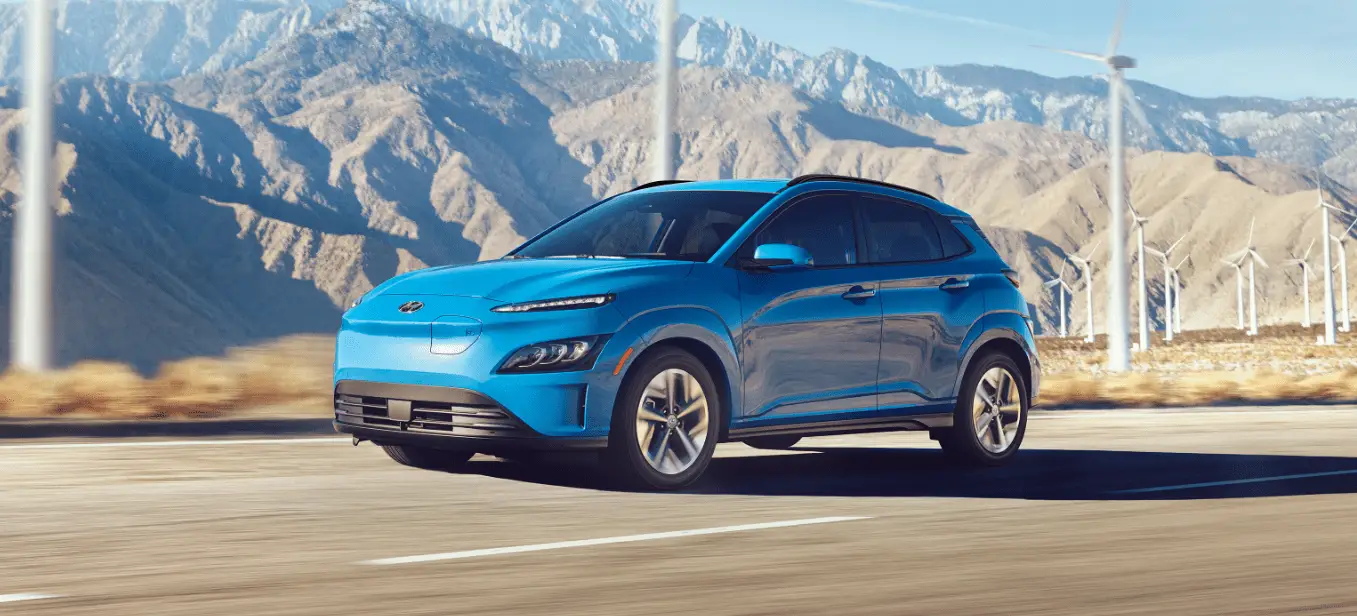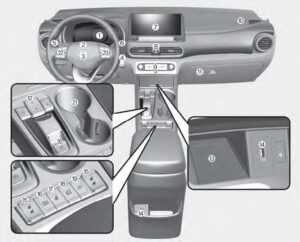Hyundai Kona-EV 2023 Vehicle Information
The 2023 Hyundai Kona-EV is the start of a new era in electric transportation because it combines environmental friendliness with high performance. This amazing electric vehicle (EV) shows how committed Hyundai is to new ideas. It drives in a way that is both good for the environment and thrilling. The Kona-EV has a sleek and modern look that not only gets people’s attention but also makes the most of airflow for maximum efficiency. Inside, it’s powered by a high-tech electric motor that provides instant torque for quick acceleration and a thrilling ride. This electric vehicle (EV) has a great range on a single charge, so it can take you on trips near and far without sacrificing style or comfort. The 2023 Hyundai Kona-EV is your reliable travel partner, whether you’re driving in the city or across the country. It changes what it means to drive an electric car in a world where style and sustainability come together.
2023 Hyundai Tuscon Specs, Price, Features, Milage (Brochure)
Exterior overview
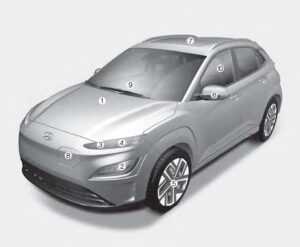
The actual shape may differ from the illustration.
- Hood
- Headlamp
- DRL (Daytime Running Light)
- Turn signal lamp
- Tires and wheels
- Outside rearview mirror
- Sunroof
- Charging door
- Front windshield wiper blades.
- Windows
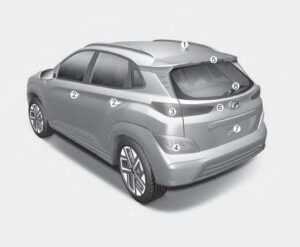
The actual shape may differ from the illustration.
- Antenna
- Doors
- Rear combination lamp
- Turn signal lamp, Back-up lamp
- High-mounted stop lamp
- Liftgate
- Rearview camera
- Rear window wiper blades
Interior Overview (I)

The actual shape may differ from the illustration
- Door lock/unlock button
- Outside rearview mirror folding switch
- The outside rearview mirror control switch
- Central door lock switch
- Power window lock switch
- Power window switches
- Instrument panel illumination control switch
- Parking Safety button
- Head-up display button
- AUTO/LOCK mode selection button
- ESC OFF button
- Hood release lever
- Fuse box
- Steering wheel tilt/telescope lever
- Steering wheel
- Seat
Interior Overview (II)
The actual shape may differ from the illustration.
- Instrument cluster
- Horn6
- Driver’s front air bag
- START/STOP button
- Light control/Turn signals
- Wiper/Washer8
- Infotainment system
- Hazard warning flasher
- Automatic climate control system
- Passenger’s front air bag
- Glove box
- Reduction gear (shift button)
- Wireless cellular phone charging system
- USB and iPod® port
- Seat warmer/Air ventilation seat
- Drive mode button
- Heated steering wheel
- Auto hold
- Parking/View button
- EPB (Electronic Parking brake)
- Cup holder
- Steering wheel audio controls/
Bluetooth® wireless technology
hands-free controls - Driving Assist button
Motor compartment
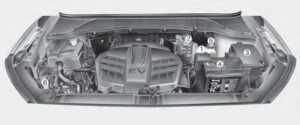
The actual motor compartment in the vehicle may differ from the illustration.
- Coolant reservoir
- Brake fluid reservoir
- Fuse box
- Battery (12 volt)
- Coolant reservoir cap
- Windshield washer fluid reservoir
Dimensions
| Items | In (mm) |
| Overall length | 165.6 (4,205) |
| Overall width | 70.9 (1,800) |
| Overall height | 61.2 (1,555) / 61.8 (1,570) *1 |
| Front tread | 61.6(1,564) |
| Rear tread | 62.0 (1,575) |
| Wheelbase | 102.4 (2,600) |
- with roof rack
Electric vehicle specifications
| Items | Specifications | |
|
Motor |
Max. output | 150 kW |
| Max. torque | 395 Nm | |
|
Battery (Lithium-ion Polymer) |
Capacity | 64 kWh |
| Power output | 170 kW | |
| Voltage | 356 V | |
| Charger (OBC) | Max. Output | 7.2 kW |
OBC : On-Board Battery Chargers
Bulb wattage
| Light Bulb | Bulb Type | Wattage | ||
|
Front |
Headlight |
Low (Type A) | HB3 | 65 |
| High (Type A) | HB3 | 65 | ||
| Low (Type B) | LED | LED | ||
| High (Type B) | LED | LED | ||
| Turn signal lamp | PY21W | 21 | ||
| Turn signal lamp (Outside mirror) | LED | LED | ||
| Daytime running lamp (DRL) / position lamp | LED | LED | ||
| Side marker | LED | LED | ||
|
Rear |
Rear combination lamp |
Stop/Tail (Type A) | P21/5W | 5 |
| Tail (Type A) | W5W | 5W | ||
| Stop/Tail (Type B) | LED | LED | ||
| Turn signal | P21W | PY21W | ||
| Back up | P21W | 21 | ||
| Fog lamp | PR21W | 21 | ||
| Side marker | Type A | W5W | 5W | |
| Type B | LED | LED | ||
| High-mounted stop lamp | LED | LED | ||
| License plate lamp | W5W | 5 | ||
|
Interior |
Map lamp | Type A | W10W | 10 |
| Type B | LED | LED | ||
| Room lamp | Type A | FESTOON | 8 | |
| Type B | LED | LED | ||
| Vanity mirror lamp | FESTOON | 5 | ||
| Luggage compartment lamp | Type A | FESTOON | 10 | |
| Type B | LED | LED | ||
Tires and wheels
|
Item |
Tire size |
Wheel size |
Inflation pressure psi (kPa) | Wheel bolt torque kgf·m (lbf·ft, N·m) | |||
| Normal load *1 | Maximum load | ||||||
| Front | Rear | Front | Rear | ||||
|
Full size tire |
215/55 R17 |
7.0J X 17 |
250 (36) |
250 (36) |
250 (36) |
250 (36) |
11~13 (79~94, 107~127) |
Normal load : Up to 3 persons
NOTICE
- It is permissible to add 3 psi (20 kPa) to the standard tire pressure specification if colder temperatures are expected soon. Tires typically lose 1 psi (7 kPa) for every 12°F (7°C) temperature drop. If extreme temperature variations are expected, recheck your tire pressures as necessary to keep them properly inflated.
- As air pressure generally decreases, as you drive up to a high-altitude area above
sea level. Thus, if you plan to drive a high-altitude area, check the tire pressures in advance. If necessary, inflate them to a proper level (Air inflation per altitude:
+2.4 psi/1 mile (+10 kPa/1 km)).
CAUTION
When replacing tires, ALWAYS use the same size, type, brand, construction and tread pattern supplied with the vehicle. If not, replaced tires can damage the related parts or make them work irregularly.
Air conditioning system
| Items | Weight of volume | Classification | |
| Refrigerant
oz. (g) |
With standard climate control system | 19.4 ± 0.9 (550 ± 5) |
R-1234yf |
| With inner condenser | 22.9 ± 0.9 (650 ± 25) | ||
| With inner condenser | 35.3 ± 0.9 (1,000 ± 5) | ||
| Compressor lubricant
oz. (g) |
6.34 ± 0.35 (180 ± 10) | POE | |
For more details, contact an authorized HYUNDAI dealer.
Volume and weight
|
Gross vehicle weight |
Luggage volume | |
| Min. | Max. | |
| 4,762 lbs. (2,160 kg) | 11 7 FX IW 332 Ţ | 39 3 FX IW 1,114 Ţ |
Min: Behind rear seat to roof
Max: Behind the front seat to the roof
Recommended lubricants and capacities
To help achieve proper vehicle performance and durability, use only lubricants of the proper quality. These lubricants and fluids are recommended for use in your vehicle.
| Lubricant | Volume | Classification | |
| Reduction gear fluid |
0.26 ~ 0.29 US gallon |
70W, API GL-4, TCGO-9(MS517-14) or
other brands meeting the above specification approved by HYUNDAI |
|
|
Coolant |
without heat pump | 3.3 ~ 3.4 US gallon
12 5 a13 Ţ |
Designated coolant water for electric vehicles |
| with heat pump | 3.6 ~ 3.5 US gallon
13 a13 4 Ţ |
||
|
Brake fluid |
0.18 ~ 0.21 US gallon
0 7 a 0 8 Ţ |
SAE J1704 DOT-4 LV, FMVSS 116 DOT-4, ISO 4925 CLASS-6 |
|
2023 Hyundai Tuscon Specs, Price, Features, Milage (Brochure)
Vehicle Identification Number (VIN)
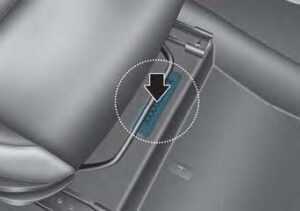
The vehicle identification number (VIN) is the number used in registering your vehicle and in all legal matters pertaining to its ownership, etc. The number is punched on the floor under the right front seat. To check the number, open the cover.
- VIN label (if equipped)

The VIN is also on a plate attached to the top of the left side dashboard. The number on the plate can easily be seen through the windshield from outside.
Vehicle certification label

The vehicle certification label attached on the driver’s (or front passenger’s) side center pillar gives the vehicle identification number (VIN).
Tire specification and pressure label

The tires supplied on your new vehicle are chosen to provide the best performance for normal driving. The tire label located on the driver’s side centre pillar gives the tire pressures recommended for your vehicle.
Motor number

The motor number is stamped on the motor block as shown in the drawing. The motor number can be seen from under the vehicle.
Air conditioner compressor label
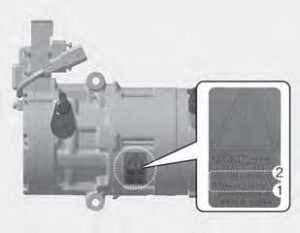
A compressor label informs you the type of compressor your vehicle is equipped with such as model, supplier part number, production number, refrigerant (1) and refrigerant oil (2).
CONSUMER INFORMATION
This consumer information has been prepared by regulations issued by the National Highway Traffic Safety Administration of the U.S. Department of Transportation. Your HYUNDAI dealer will help answer any questions you may have as you read this information. HYUNDAI motor vehicles are designed and manufactured to meet or exceed all applicable safety standards. For your safety, however, we strongly urge you to read and follow all directions in this Owner’s Manual, particularly the information under the headings “NOTICE”, “CAUTION” and “WARNING”. If, after reading this manual, you have any questions regarding the operation of your vehicle, please contact the Hyundai Customer Care Center.
Hyundai Customer Care
P.O. Box 20850
Fountain Valley, CA 92728
800-633-5151
Hyundai’s Customer Care representatives are available Monday through Friday, between the hours of 6:00 AM and 5:00 PM PST and Saturday between 6:30 AM and 3:00 PM PST (English). For Customer Care assistance in Spanish or Korean, representatives are available Monday through Friday between 6:30 AM and 3:00 PM PST.
REPORTING SAFETY DEFECTS
If you believe that your vehicle has a defect that could cause a crash or could cause injury or death, you should immediately inform the National Highway Traffic Safety Administration (NHTSA) in addition to notifying HYUNDAI MOTOR AMERICA. To contact NHTSA, you may call the Vehicle Safety Hotline toll-free at 1-888-327-4236 (TTY: 1-800-424-9153) download the SaferCar mobile application; or write to: Administrator, NHTSA 1200 New Jersey Ave, SE, West Building Washington, D.C. 20590. If NHTSA receives similar complaints, it may open an investigation, and if it finds that a safety defect exists in a group of vehicles, it may order a recall and remedy campaign. However, NHTSA cannot become involved in individual problems between you, your dealer, or HYUNDAI MOTOR AMERICA.
FAQ
The range can vary based on factors like driving conditions and battery capacity, but the 2023 Kona EV typically offers a range of around 250 to 300 miles.
The Kona EV 2023 often offers instant torque and a smooth acceleration experience, similar to or even better than its gasoline counterpart.
The Kona EV 2023 can be charged using standard home outlets (Level 1 charging) or dedicated electric vehicle charging stations (Level 2 charging). It also supports DC fast charging for quicker charging times.
Depending on your location, the Kona EV 2023 might be eligible for government incentives or tax credits for electric vehicles, which can help reduce the purchase price.
Yes, the Kona EV 2023 often comes with different driving modes such as Eco, Normal, and Sport, which can adjust the vehicle’s performance characteristics and energy consumption.
Yes, the Kona EV 2023 often offers regenerative braking systems that capture energy during deceleration and braking, helping to recharge the battery.
Many models of the Kona EV 2023 come with smartphone apps that allow you to remotely control charging, pre-conditioning, and other vehicle functions.
The Kona EV 2023 typically offers advanced safety features such as automatic emergency braking, lane-keeping assist, adaptive cruise control, and more.
The Kona EV 2023 often provides a quiet and smooth driving experience due to the absence of an internal combustion engine. Instant torque delivery also contributes to responsive acceleration.
Yes, the Kona EV 2023’s range makes it suitable for long trips, especially with access to charging infrastructure along the way.
While the upfront cost might be higher due to the battery and technology, the Kona EV 2023 typically offers lower operating costs due to lower fuel and maintenance expenses.
Useful Link
View Full User Guide: Hyundai Kona-EV 2023 User Guide
Hyundai Kona-EV 2023 Child Restraint System (CRS) User Guide
2023 Hyundai Tuscon Specs, Price, Features, Milage (Brochure)

